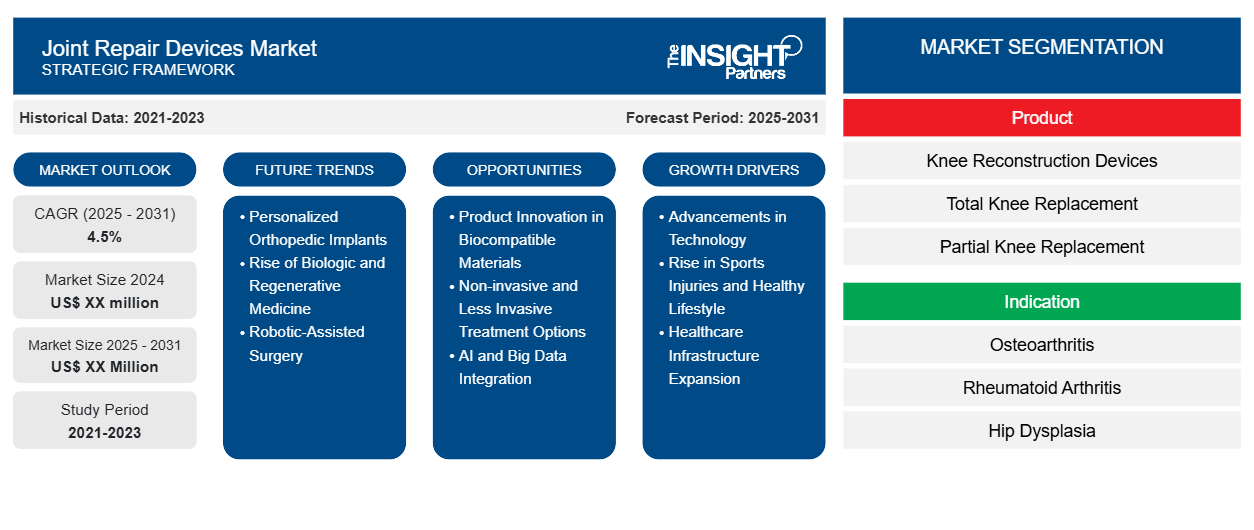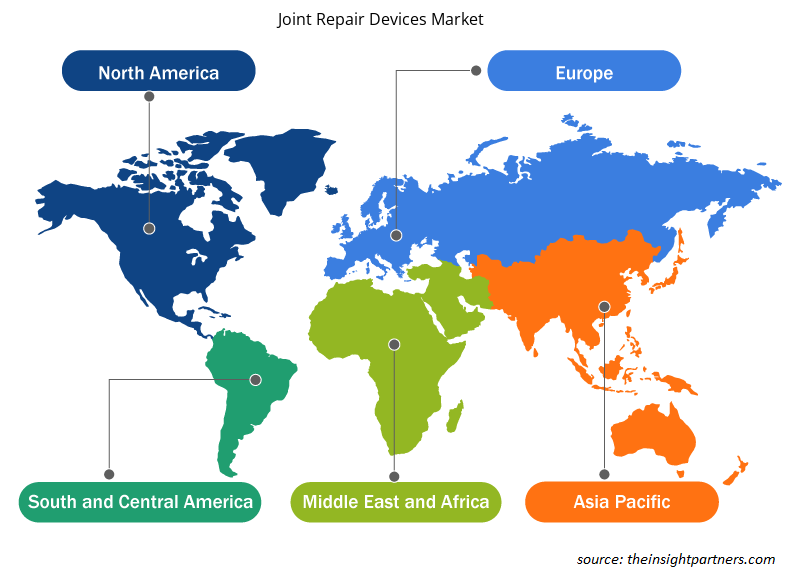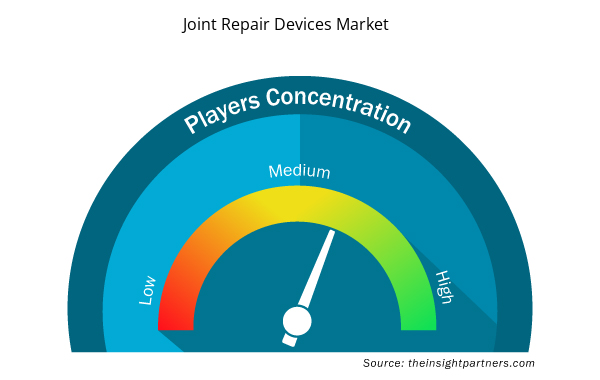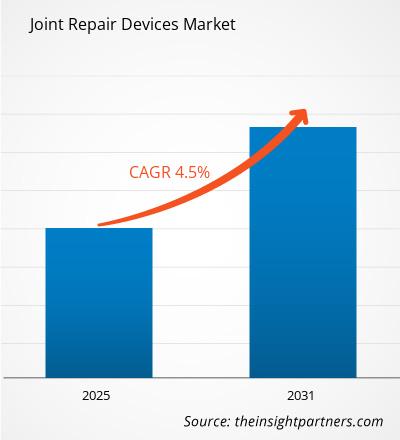The Joint Repair Devices Market is expected to register a CAGR of 4.5% from 2025 to 2031, with a market size expanding from US$ XX million in 2024 to US$ XX Million by 2031.
The report is segmented by Product (Knee Reconstruction Devices, Total Knee Replacement, Partial Knee Replacement, Revision Total Knee Replacement, Hip Reconstruction Devices, Others). The report is segmented by Indication (Osteoarthritis, Rheumatoid Arthritis, Hip Dysplasia, Orthopaedic Trauma, Others). The report is segmented by Joint Type (Knee, Hip, Shoulder, Ankle, Others). The report is segmented by End User (Hospitals, Rehabilitation Centers, Others). The global analysis is further broken-down at regional level and major countries. The Report Offers the Value in USD for the above analysis and segments.
Purpose of the Report
The report Joint Repair Devices Market by The Insight Partners aims to describe the present landscape and future growth, top driving factors, challenges, and opportunities. This will provide insights to various business stakeholders, such as:
- Technology Providers/Manufacturers: To understand the evolving market dynamics and know the potential growth opportunities, enabling them to make informed strategic decisions.
- Investors: To conduct a comprehensive trend analysis regarding the market growth rate, market financial projections, and opportunities that exist across the value chain.
- Regulatory bodies: To regulate policies and police activities in the market with the aim of minimizing abuse, preserving investor trust and confidence, and upholding the integrity and stability of the market.
Joint Repair Devices Market Segmentation
Product
- Knee Reconstruction Devices
- Total Knee Replacement
- Partial Knee Replacement
- Revision Total Knee Replacement
- Hip Reconstruction Devices
- Others
Indication
- Osteoarthritis
- Rheumatoid Arthritis
- Hip Dysplasia
- Orthopaedic Trauma
- Others
Joint Type
- Knee
- Hip
- Shoulder
- Ankle
- Others
End User
- Hospitals
- Rehabilitation Centers
- Others
Customize This Report To Suit Your Requirement
You will get customization on any report - free of charge - including parts of this report, or country-level analysis, Excel Data pack, as well as avail great offers and discounts for start-ups & universities
Joint Repair Devices Market: Strategic Insights

- Get Top Key Market Trends of this report.This FREE sample will include data analysis, ranging from market trends to estimates and forecasts.
Joint Repair Devices Market Growth Drivers
- Advancements in Technology: Even newer technological advances relating to joint repair devices include materials that are improved toughness, such as titanium alloys, ceramics, and polyethylene, with related improvement in the efficacy and longevity of joint replacement. The advent of robotic surgery, 3D printing, and computer-assisted surgery techniques also led to even greater precision and refinement of joint replacement procedures, which were less invasive, leading to faster recovery and better results. These innovations are the drivers of growth in the market as they offer safe yet more effective treatment options for patients.
- Rise in Sports Injuries and Healthy Lifestyle: Because the number of sports and fitness practice is significantly increasing among all age groups, there is an increasing incidence of sports-related injury. Among those who engage in sports and physical activity, joint injuries rank as one of the top-listed conditions, with the knee and shoulder most commonly involved. Most of these are surgical interventions involving repair/reconstruction of the joint. The use of devices for repair of joints, including arthroscopic instruments, devices to perform ligament repair, and prosthetics, is increasing.
- Healthcare Infrastructure Expansion: Increase in expansion of health care infra - such as innovative, especially in emerging markets-is contributing to growth in the joint repair devices market. Further, expansion of modernized orthopedic surgeries and, subsequently, joint repair treatments is witnessed in those countries. Increasing access to advanced medical technologies and a better-trained health care professional are generating growing demand for such procedures in patients in those regions.
Joint Repair Devices Market Future Trends
- Personalized Orthopedic Implants: This represents a movement toward greater customization and personalization of joint repair devices because anatomical variability from patient to patient most assuredly impacts the fit and function of these joint implants. Improvements in 3D printing and the development of patient-specific imaging have allowed for implants to be generated that reflect the personal characteristics of each patient. A more personal approach results in better alignment, less wear over time, and potentially improved clinical results.
- Rise of Biologic and Regenerative Medicine: The latest surge in interest for biologics and regenerative treatments is an important trend observed in the joint repair devices market. Alternate methods, such as stem cell therapy, platelet-rich plasma (PRP) injections, and gene therapy, are being researched as adjunct treatments to traditional joint repair devices. These therapies look forward to regrowing or replacement of damaged tissues in an attempt to minimize or obviate full joint replacement. Companies are fast integrating these regenerative approaches with surgical devices to enhance overall treatment outcomes.
- Robotic-Assisted Surgery: This is the wave that will alter doing joint replacement surgery with much more precision. The robotic systems with examples such as Mako's robotic-arm-assisted surgery platform provide the capability of strong planning and execution of the procedure, thus minimizing human error and optimizing prosthetic alignment. Trend shall continue to rise as robotic technology improves and more surgeons begin using these types of systems in their joint replacement surgeries-mostly for knees and hips.
Joint Repair Devices Market Opportunities
- Product Innovation in Biocompatible Materials: The development of new biocompatible materials for joint implants becomes a significant opportunity for market players. Advanced polymers, ceramic materials, and hybrid composites are also researched to improve the efficacy and duration of implants. Biocompatible materials can also help reduce infections and complications as they arise after implantation surgeries in patients. The future holds promise in the area of implant production, where joints can actually feel a lot like natural joints and probably last longer.
- Non-invasive and Less Invasive Treatment Options: The increase of interest of patients in alternative alternatives to surgery creates a space for joint repair device manufacturers to create non-invasive and less invasive products. Technologies such as cryotherapy, ultrasound, and electric field therapy are incorporated into joint repair devices to control pain and accelerate healing. In the future, new treatments that can repair cartilage damage or trigger tissue regeneration without the need to replace the joint can be an attractive option for large segments of patients.
- AI and Big Data Integration: The integration of AI with big data will open up massive potential in the joint repair devices market. For example, orthopedic surgeons can predict surgical outcomes more precisely with machine learning algorithms and patient data analytics that optimize joint implant placement as well as tracking the recovery post-surgery. In addition, AI could be applied to an implant design tailored to the uniqueness of the individual's biomechanics and anatomy. Companies that decide on wiser judgment decisions and after post-surgical care would gain by putting into use big data with AI.
Joint Repair Devices Market Regional Insights
The regional trends and factors influencing the Joint Repair Devices Market throughout the forecast period have been thoroughly explained by the analysts at Insight Partners. This section also discusses Joint Repair Devices Market segments and geography across North America, Europe, Asia Pacific, Middle East and Africa, and South and Central America.

- Get the Regional Specific Data for Joint Repair Devices Market
Joint Repair Devices Market Report Scope
| Report Attribute | Details |
|---|---|
| Market size in 2024 | US$ XX million |
| Market Size by 2031 | US$ XX Million |
| Global CAGR (2025 - 2031) | 4.5% |
| Historical Data | 2021-2023 |
| Forecast period | 2025-2031 |
| Segments Covered |
By Product
|
| Regions and Countries Covered | North America
|
| Market leaders and key company profiles |
Joint Repair Devices Market Players Density: Understanding Its Impact on Business Dynamics
The Joint Repair Devices Market market is growing rapidly, driven by increasing end-user demand due to factors such as evolving consumer preferences, technological advancements, and greater awareness of the product's benefits. As demand rises, businesses are expanding their offerings, innovating to meet consumer needs, and capitalizing on emerging trends, which further fuels market growth.
Market players density refers to the distribution of firms or companies operating within a particular market or industry. It indicates how many competitors (market players) are present in a given market space relative to its size or total market value.
Major Companies operating in the Joint Repair Devices Market are:
- Aesculap Implant Systems, LLC
- Conmed Corporation
- DePuy Synthes Companies
- Donjoy Inc.
- Medtronic Inc
Disclaimer: The companies listed above are not ranked in any particular order.

- Get the Joint Repair Devices Market top key players overview
Key Selling Points
- Comprehensive Coverage: The report comprehensively covers the analysis of products, services, types, and end users of the Joint Repair Devices Market, providing a holistic landscape.
- Expert Analysis: The report is compiled based on the in-depth understanding of industry experts and analysts.
- Up-to-date Information: The report assures business relevance due to its coverage of recent information and data trends.
- Customization Options: This report can be customized to cater to specific client requirements and suit the business strategies aptly.
The research report on the Joint Repair Devices Market can, therefore, help spearhead the trail of decoding and understanding the industry scenario and growth prospects. Although there can be a few valid concerns, the overall benefits of this report tend to outweigh the disadvantages.
- Historical Analysis (2 Years), Base Year, Forecast (7 Years) with CAGR
- PEST and SWOT Analysis
- Market Size Value / Volume - Global, Regional, Country
- Industry and Competitive Landscape
- Excel Dataset


- Identity Verification Market
- Mail Order Pharmacy Market
- Investor ESG Software Market
- Lymphedema Treatment Market
- Predictive Maintenance Market
- Smart Mining Market
- Smart Parking Market
- Excimer & Femtosecond Ophthalmic Lasers Market
- Wheat Protein Market
- Quantitative Structure-Activity Relationship (QSAR) Market

Report Coverage
Revenue forecast, Company Analysis, Industry landscape, Growth factors, and Trends

Segment Covered
This text is related
to segments covered.

Regional Scope
North America, Europe, Asia Pacific, Middle East & Africa, South & Central America

Country Scope
This text is related
to country scope.
Frequently Asked Questions
The Joint Repair Devices Market is estimated to witness a CAGR of 4.5% from 2023 to 2031
The major factors driving the Joint Repair Devicesmarket are:
1. Advancements in Technology
2. Rise in Sports Injuries and Healthy Lifestyle
Product Innovation in Biocompatible Materials act as a opportunity for growth of the market in forecast period.
North America region dominated the Joint Repair Devices market in 2023.
Osteoarthritis segment, by Indication, dominated the market in 2023.
Players operating in the market are Aesculap Implant Systems, LLC, Conmed Corporation, DePuy Synthes Companies, Donjoy Inc., Medtronic Inc, Nuvasive, Inc, Smith & Nephew PLC, Stryker Corporation, Wright Medical Technology Inc, Zimmer Biomet
Trends and growth analysis reports related to Life Sciences : READ MORE..
1. Aesculap Implant Systems, LLC
2. Conmed Corporation
3. DePuy Synthes Companies
4. Donjoy Inc.
5. Medtronic Inc
6. Nuvasive, Inc
7. Smith & Nephew PLC
8. Stryker Corporation
9. Wright Medical Technology Inc
10. Zimmer Biomet

 Get Free Sample For
Get Free Sample For